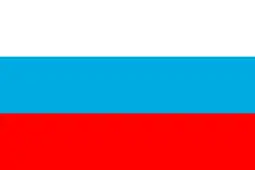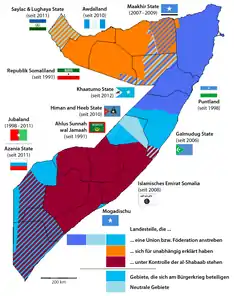Azania (Somalia)
Azania (Somali: Azaaniya, Arabic: أزانيا), officially the Republic of Azania (Somali: Dawladda Azaaniya) was a self-proclaimed autonomous state entity in southern Somalia. Proclaimed on 3 April 2011 in the Nairobi, capital of Kenya, where an administration was established that claimed to govern the Somali region of Jubaland. Like Puntland, Azania was formally declared an autonomous region (state) within Federal Somalia.[1][2]
Azania
| |||||||||
|---|---|---|---|---|---|---|---|---|---|
 | |||||||||
 | |||||||||
| Capital | Dhobley Garbahare | ||||||||
| Largest city | Dhobley, Jamame, Kismayo | ||||||||
| Official languages |
| ||||||||
| Demonym(s) | Somali | ||||||||
| Government | Presidential democracy | ||||||||
• President | Mohamed Abdi Mohamed Gandhi | ||||||||
| Establishment | |||||||||
• Proclaimed | 3 April 2011 | ||||||||
• Dissolved | 15 May 2013 | ||||||||
| Currency | Somali shilling (SOS) | ||||||||
| Time zone | UTC+3 (EAT) | ||||||||
| UTC+3 (not observed) | |||||||||
| Calling code | +252 (Somalia) | ||||||||
| ISO 3166 code | SO | ||||||||
| Internet TLD | .so | ||||||||
| |||||||||
The map shows the territories (blue) claimed by Azania. | |||||||||
Azania was a short-lived attempt to reconstitute Jubaland (which was completely taken over by the islamist militant group Harakat al-Shabaab in 2010), but when Kenya launched a massive offensive against al-Shabab (known as Operation Linda Nchi) in the fall of 2011, Kenya began to support among the intra-Somali forces not so much Azania as the Raskamboni Movement, which, after the partial liberation of Jubaland, formed a new administration in 2013.
Although Azania formally represented all three provinces of Jubaland, it is difficult to determine which specific territory the Azania administration actually controlled.[3]
The name "Azania" is a historical name for various regions of Africa. According to President Gandhi, a trained anthropologist and historian, Azania was selected as the name for the new administration because of its historical importance, as "Azania was a name given to Somalia more than 2,500 years ago and it was given by Egyptian sailors who used to get a lot of food reserves from the Somali Coas. Its origin is [an] Arabic word meaning the land of plenty."[4][5]
Overview and background
The main initiator of the creation of Azania was Kenya, which needed a buffer state on the border with neighboring Somalia, which has been in a state of civil war since 1991 and has split into zones of influence of clans. In an effort to create such a state, Kenya had trained 2,500 fighters by 2010 and created a virtual administrative structure led by Mohamed Abdi Mohamed Gandhi, the former Minister of Defence.[6]
At the time before the declaration of Azania, all of Jubaland was under the control of Harakat al-Shabaab.
Declaration of independence
On 3 April 2011 after several days of fighting with Kenyan air support supporters of the Transitional federal government (TGF) and the Raskamboni Movement managed to occupy the Dhobley near the Kenyan border crossing where Somali refugees are concentrated.[7][8][9] On the same day, a ceremony was held in Nairobi to proclaim the new state of Azania.[10] Mohamed Abdi Mohamed Gandhi was declared President of Azania.[11] The new head of the new state declared the fight against Harakat al-Shabab to be the main task of Azania.[12][13] "Our aim of establishing this administration is to first liberate these regions," he said. "We are not breaking away from Somalia."[14] On 7 April Azania controlled a small area centered on Dhobley.
While Azania was considered by Kenya to be a project of the Jubaland administration, several groups not affiliated with al-Shabab took part in the military operations against al-Shabab.[15] The most powerful of these (and also supported by Kenya) was the Raskamboni Movement, which was led by Sheikh Ahmed Mohamed Islam Madobe, later President of the freed Jubaland. While the Azania project was largely supported by Kenyan intellectual and political circles, Madobe had massive support among Kenyan-Somali officers.[6]

After supporters of the Transitional federal government and the Raskamboni Movement managed to occupy the Dhobley and gain a foothold on a section of border territory with Kenya, representatives of the Azania administration went to Dobley; however, Azania's relations with Raskamboni were strained, and the Azania administration was rejected by Raskamboni leaders.[15][16]
On the Northern side, the offensive was carried out by the Ahlu Sunna Waljamaa'a group, which occupied the Luk in Gedo region on 28 April 2011.[17] On 3 May 2011, the Garbahare was occupied. However, Ahlu Sunna Waljamaa'a also refused to recognize the Azania administration. On 29 June 2011, Mohamed Abdi Kalil, the head of the Transitional federal government of Somalia administration in the Gedo region, accused the Azania government of having links to Harakat al-Shabab and, moreover, fighting alongside them against the Transitional Federal government.[18]
International reaction

![]() Kenya: The government of neighboring Kenya at the time of Azania's creation expressed the hope that Azania would be able to protect the country from the prevailing anarchy in Somalia (by becoming a buffer state).
Kenya: The government of neighboring Kenya at the time of Azania's creation expressed the hope that Azania would be able to protect the country from the prevailing anarchy in Somalia (by becoming a buffer state).
![]() Somalia: The country's transitional government, which tried to unify Somalia, soon condemned Azania's declaration of independence.
Somalia: The country's transitional government, which tried to unify Somalia, soon condemned Azania's declaration of independence.
![]() Ethiopia: The Ethiopian authorities also opposed the creation of this state, as, in their opinion, this could lead to increased separatist sentiment in the Ogaden, inhabited by Somalis.[19]
Ethiopia: The Ethiopian authorities also opposed the creation of this state, as, in their opinion, this could lead to increased separatist sentiment in the Ogaden, inhabited by Somalis.[19]
Further events
Shortly after the proclamation, a full-scale military operation Linda Nchi of the Kenyan army (with the support of Ethiopia and the TFG) was launched throughout Jubaland), ending in 2012 with the partial ousting of Harakat al-Shabab forces and the capture of Kismayo.
After that, a new Federal Government was formed in the Mogadishu, and on 15 May 2013, the autonomous state of Jubaland was proclaimed throughout Jubaland region, headed by Ahmed Mohamed Islam Madobe, the leader of Raskamboni,[20] which to this day, together with the forces of the Federal Government, is fighting the forces of Harakat al-Shabab. References to the idea of the state of Azania after its proclamation, in connection with these events, quickly faded away.
References
- Wehel Media Center " Somalia creates new state, Azania, latest of at least 10 new administrations recently added
- "Somalia creates new state, Azania". Associated Press. 2015-03-27. Retrieved 2020-11-17.
- The true objective of Kenia in Somalia
- Ibrahim, Abdifitah (4 June 2011) Azania President Vows To Defeat Al-Shabaab Archived 13 June 2012 at the Wayback Machine. Somaliareport.com. Retrieved on 22 April 2013.
- "Biyokulule Online". biyokulule.com. Retrieved 28 November 2017.
- The Kenyan military intervention in Somalia, page 2
- Hiiraan Online. "Government Forces Capture Dhobley Town". Retrieved 2011-04-05.
- Shabelle Media Network. "Somalia: Injured Al shabaab fighters brought to Kismayo". Archived from the original on 2011-07-23. Retrieved 2011-04-05.
- Shabelle Media Network. "Somali govt confiscates Dhobley after days of fighting". Archived from the original on 2011-07-23. Retrieved 2011-04-05.
- "Азания отделилась от Сомали" (in Russian). Росбалт. 2011-04-04.
- "Kenya intends to create a "buffer" state in Somalia, Azania" (in Russian). PortNews. 2011-04-04.
- A new state appeared in Africa (in Russian). 2011-04-04.
- "Kenya tries to create a buffer state of Azania in Somalia" (in Russian). RIA Novosti. 2014-04-04.
- Muhumed, Malkhadir M., Associated Press (2011-04-03). "Somalia creates new state, Azania, latest of at least 10 new administrations recently added". StarTribune. Archived from the original on 2016-03-03.CS1 maint: multiple names: authors list (link)
- "The Kenyan Military Intervention in. Somalia" (PDF). International Crisis Group. Archived from the original (PDF) on 2016-03-27. Retrieved 2012-05-11.
- Rift Over Azania Visit in Dhobley Archived 2014-12-26 at the Wayback Machine
- PressTV — Somali clashes leave 35 dead
- Somalia’s Azania Administration Has Links With Al Shabaab
- Former Somali Defense Minister Named President of Jubaland Archived 2011-04-08 at the Wayback Machine
- "Former Islamist warlord elected president of Somali region". 2013-05-15.